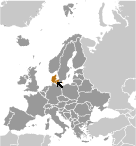World Atlas: Denmark. On this page you can see the map, country flag and many detailed information about the people, history and economy of Denmark.

Here you can find online selected information about the geography, inhabitants, government, economy and history of Denmark. Included are selected statistics, an overview map and the detailed map of Denmark. But let's start with the flag of Denmark here:
Denmark - Overview:
What you should know about Denmark? Let's start with this: Once the seat of Viking raiders and later a major north European power, Denmark has evolved into a modern, prosperous nation that is participating in the general political and economic integration of Europe. It joined NATO in 1949 and the EEC (now the EU) in 1973. However, the country has opted out of certain elements of the EU's Maastricht Treaty, including the European Economic and Monetary Union, European defense cooperation, and issues concerning certain justice and home affairs.
Geography of Denmark
 Where on the globe is Denmark? The location of this country is Northern Europe, bordering the Baltic Sea and the North Sea, on a peninsula north of Germany (Jutland); also includes several major islands (Sjaelland, Fyn, and Bornholm). Total area of Denmark is 43,094 sq km, of which 42,434 sq km is land. So this is not a large country. How could we describe the terrain of the country? This way: low and flat to gently rolling plains. The lowest point of Denmark is Lammefjord -7 m, the highest point Mollehoj/Ejer Bavnehoj 171 m. And the climate is temperate; humid and overcast; mild, windy winters and cool summers.
Where on the globe is Denmark? The location of this country is Northern Europe, bordering the Baltic Sea and the North Sea, on a peninsula north of Germany (Jutland); also includes several major islands (Sjaelland, Fyn, and Bornholm). Total area of Denmark is 43,094 sq km, of which 42,434 sq km is land. So this is not a large country. How could we describe the terrain of the country? This way: low and flat to gently rolling plains. The lowest point of Denmark is Lammefjord -7 m, the highest point Mollehoj/Ejer Bavnehoj 171 m. And the climate is temperate; humid and overcast; mild, windy winters and cool summers.
Inhabitants of Denmark
Let's take a look how many people live in Denmark. The number is: 5,605,948 (July 2017 est.). So this is not very populous country. Who lives here? Danish (includes Greenlandic (who are predominantly Inuit) and Faroese) 86.7%, Turkish 1.1%, other 12.2% (largest groups are Polish, Syrian, German, Iraqi, and Romanian). What are the languages in Denmark? Danish, Faroese, Greenlandic (an Inuit dialect), German (small minority). And the religions: Evangelical Lutheran (official) 76%, Muslim 4%, other (denominations of less than 1% each, includes Roman Catholic, Jehovah's Witness, Serbian Orthodox Christian, Jewish, Baptist, and Buddhist) 20% (2017 est.). How old are the people in average? 42.2 years. We have to add that this number is the median - so one half of the people is older than this, one half is younger. And what is their life expectancy (at birth)? This: 79.5 years. Where the people live in Denmark? Here: with excellent access to the North Sea, Skagerrak, Kattegat, and the Baltic Sea, population centers tend to be along coastal areas, particularly in Copenhagen and the eastern side of the country's mainland. The major urban areas of Denmark are: Copenhagen (capital) 1.268 million (2015).
Government and Economy of Denmark
The capital of Denmark is Copenhagen and the government type parliamentary constitutional monarchy. Let's take a look at the administrative divisions - metropolitan Denmark - 5 regions (regioner, singular - region); Hovedstaden (Capital), Midtjylland (Central Jutland), Nordjylland (North Jutland), Sjaelland (Zealand), Syddanmark (Southern Denmark). Regarding the economy of Denmark, important industrial products are iron, steel, nonferrous metals, chemicals, food processing, machinery and transportation equipment, textiles and clothing, electronics, construction, furniture and other wood products, shipbuilding and refurbishment, windmills, pharmaceuticals, medical equipment. Important agricultural products are barley, wheat, potatoes, sugar beets; pork, dairy products; fish. The most important export commodities are machinery and instruments, meat and meat products, dairy products, fish, pharmaceuticals, furniture and design, windmills and the most important export partners are Germany 16.3%, Sweden 11.9%, US 8.2%, UK 6.5%, Norway 6.1%, Netherlands 5.1%, China 4.4% (2016). The most important import commodities are machinery and equipment, raw materials and semimanufactures for industry, chemicals, grain and foodstuffs, consumer goods and the most important import partners are Germany 21.4%, Sweden 12.2%, Netherlands 8%, China 7.3%, Norway 5.5%, UK 4.2% (2016). How rich is Denmark and how rich are people in this country? The most important number here is GDP per capita (PPP): $49,600 (2017 est.). This means the people are rich on average here. Let's add that this means Gross Domestic Product per person, which is recalculated with respect to the relative cost of local goods and services. And one more important number - population below poverty line: 13.4% (2011 est.).